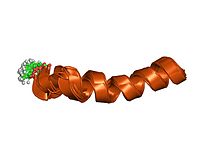Vpr
| VPR | |||||||||
|---|---|---|---|---|---|---|---|---|---|

solution structure of hiv-1 vpr (13-33) peptide in micells
|
|||||||||
| Identifiers | |||||||||
| Symbol | VPR | ||||||||
| Pfam | PF00522 | ||||||||
| InterPro | IPR000012 | ||||||||
| SCOP | 1dsk | ||||||||
| SUPERFAMILY | 1dsk | ||||||||
| TCDB | 1.A.42 | ||||||||
|
|||||||||
| Available protein structures: | |
|---|---|
| Pfam | structures |
| PDB | RCSB PDB; PDBe; PDBj |
| PDBsum | structure summary |
Vpr is a Human immunodeficieny viral gene and protein product.
Vpr stands for "Viral Protein R". Vpr, a 96 amino acid 14-kDa protein, plays an important role in regulating nuclear import of the HIV-1 pre-integration complex, and is required for virus replication in non-dividing cells such as macrophages. Vpr also induces G2 cell cycle arrest and apoptosis in proliferating cells, which can result in immune dysfunction.
Vpr is also immunosuppressive due to its ability to sequester a proinflammatory transcriptional activator in the cytoplasm. HIV-2 contains both a Vpr protein and a related (by sequence homology) Vpx protein (Viral Protein X). Two functions of Vpr in HIV-1 are split between Vpr and Vpx in HIV-2, with the HIV-2 Vpr protein inducing cell cycle arrest and the Vpx protein required for nuclear import.
Vpr-binding protein (VprBP) is a 1,507-amino-acid human protein that contains conserved domains, including YXXY repeats, the Lis homology motif, and WD40 repeats. VprBP acts as a substrate-recognition unit when associated with DNA damage-binding protein 1 (DDB1) as part of a CUL4–DDB1 E3 ubiquitin ligase complex. When bound to Vpr, VprBP allows Vpr to modulate the catalytic activity of the CUL4–DDB1 complex, inducing G2 cell cycle arrest in infected cells.
VprBP also regulates p53-induced transcription and apoptotic pathways. p53 is an important tumor suppressor which induces either cell cycle arrest or apoptosis in response to DNA damage.
...
Wikipedia
